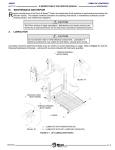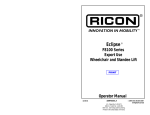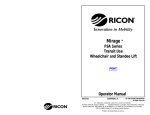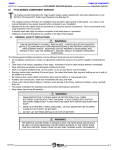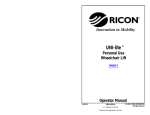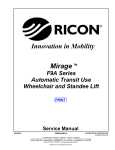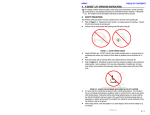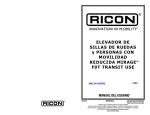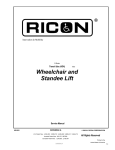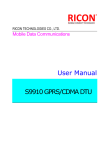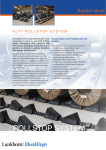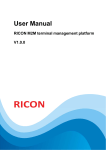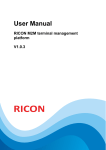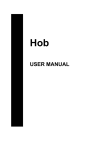Download next chapter - Ricon Corporation
Transcript
II. OPERATING INSTRUCTIONS T his chapter contains safety precautions, a daily safety check, a description of lift functions, control and indicator descriptions, plus individual operating instructions for the Ricon Mirage F9TF Public Use wheelchair and standee lift. This chapter must be thoroughly understood by the operator. A. SAFETY PRECAUTIONS The following safety precautions must be complied with at all times when operating lift: Refer to Figure 2-1. Operate lift with vehicle parked on level ground. Deploying lift when vehicle is on sloped ground is hazardous. FIGURE 2-1: VEHICLE INCLINED DUE TO SLOPE Vehicle must be safely parked with parking brake on before using lift. Inspect lift before use. Do not use lift if an unsafe condition exists, or if unusual noise or movement is noticed. Contact a Ricon authorized service technician for repair. Read and comply with all warning labels and symbols affixed to wheelchair lift. Wheelchair occupant should face outward when entering or exiting vehicle. Do not back onto platform when exiting vehicle. Face outward, if possible, and verify that platform is at the same height as floor. Check that front rollstop is up and locked. The front rollstop is intended to prevent slow, unintentional, rolling off of platform. The front rollstop is not intended to stop a quick moving wheelchair. A quick moving wheelchair could tip if the small front wheels collide with the rollstop. Also, the large rear wheels of a quick moving wheelchair could roll over the rollstop. Possible injury to the occupant might occur in either case. Verify that wheelchair fits safely on platform; it must not extend beyond edges or interfere with operation of rollstop. Do not operate with a load in excess of 660 lbs (300 kg). Keep arms, legs, and clothing away from moving lift parts. The lift is intended for one wheelchair and its occupant, or one standee. Do not overload lift. Keep others clear while operating lift. Do not allow an untrained person to operate lift. 32DF9T15.A 2-1 Do not allow anyone to stand on bridgeplate. A bent bridgeplate can interfere with the platform as it raises and lowers. Lock wheelchair brakes before raising or lowering platform (power chair users should turn off power and set brake). Use great care in wet conditions; the wheelchair brakes are less effective if its tires or the platform are wet. Do not leave deployed platform unattended. Return to stowed position after use. Read and understand the preceding safety precautions. Review them periodically and ask attendants or other operators to read them as well. Contact a Ricon authorized service technician or call Ricon Product Support if there are questions. B. PRE-OPERATION LIFT INSPECTION Refer to the “Driver Checklist” section in Chapter 3. Ricon recommends that the listed inspection points be performed each time the vehicle is put into service, or when a driver change occurs during a work-shift. This inspection can be part of the normal pre-use walk-through done by the vehicle operator. 2-2 32DF9T15.A C. PLATFORM MOTIONS Refer to Table 2-1 and Figure 2-2. The table describes the four platform motions, and the figure shows the four typical platform heights plus the stow position. TABLE 2-1: PLATFORM MOTIONS MOTION DESCRIPTION OUT Platform extends out of vehicle, or deploys. Platform lowers from present height towards ground; front rollstop DOWN * lowers when platform contacts ground. UP * IN Platform rises from present height towards vehicle floor; rollstop rises before platform leaves ground. Platform retracts into vehicle, or stows. END OF TABLE * The UP and DOWN motions operate only when platform is fully deployed. NOTE: HANDRAILS OMITTED FOR CLARITY. FLOOR HEIGHT STOWED POSITION INTERMEDIATE HEIGHT DEPLOYED POSITION GROUND LEVEL FIGURE 2-2: PLATFORM POSITIONS 32DF9T15.A 2-3 D. CONTROLS AND INDICATORS Control Pendant Refer to Figure 2-3. The lift is operated with a hand-held, hard-wired remote-control pendant. Turn on the POWER ENABLE switch and then control each lift motion by pressing an appropriate button. The POWER ENABLE switch provides power to the pendant and thereby enables the lift. When turned on, the power switch and each button illuminate. Pressing the DEPLOY button extends the platform from the lift storage compartment, and pressing the STOW button retracts the platform back into the storage compartment. Pressing the DOWN button lowers the platform towards the ground, and pressing the UP button raises the platform towards the vehicle floor. A button must be held depressed until the motion is completed. Movement of the platform can be halted at any time by releasing the button. POWER ENABLE POWER OFF ON STOW DEPLOY DEPLOY STOW UP DOWN UP DOWN FIGURE 2-3: CONTROL PENDANT Electric Circuit Breakers Refer to Figure 2-4. The circuit breakers shown interrupt electric power to specific sections of the lift if a malfunction causes an abnormally high current flow. The Control System and In/Out Motor circuit breakers are mounted on a common bracket, which is located at the top of the hydraulic pump enclosure. IN/OUT MOTOR CIRCUIT BREAKER CONTROL SYSTEM CIRCUIT BREAKER 2-4 FIGURE 2-4: LIFT CIRCUIT BREAKERS 32DF9T15.A Control System Circuit Breaker Refer to Figure 2-4. The five-amp control system circuit breaker is in the pump box. The circuit breaker button will “pop-out” when a control system short circuit occurs. Press button to reset. Do not press button and hold it if pressing and releasing does not restore power. Contact a Ricon authorized service technician for repair. In/Out Motor Circuit Breaker Refer to Figure 2-4. The 30 amp In/Out motor circuit breaker is also in the pump box. The circuit breaker button will “pop-out” when a short circuit occurs in the motor circuit that extends and retracts the platform. Press button to reset. Do not press button and hold it if pressing and releasing does not restore power. Contact a Ricon authorized service technician for repair. Main Lift Circuit Breaker Refer to Figure 2-5. The main circuit breaker is mounted in the vehicle engine or battery compartments, and will interrupt electrical power if a major short circuit occurs, particularly in the hydraulic pump motor circuit. The reset tab rotates clockwise when a short occurs. Rotate the reset tab counter-clockwise to reset breaker (as shown). Do not rotate tab and hold it if rotating and releasing does not restore power. Contact a Ricon authorized service technician for repair. RESET TAB FIGURE 2-5: MAIN CIRCUIT BREAKER – SHOWN RESET Vehicle Interlock System The purpose of the vehicle interlock system is to prevent lift operation if it is unsafe to do so. Typical requirements are that the vehicle transmission be in neutral, the parking brake be applied, and the passenger door be opened before power is supplied to the lift. Before the vehicle can depart, the lift must be stowed, and both the lift compartment door and passenger door must be closed. Bridgeplate Load Sensor A sensor switch is located in the hydraulic line connected to the bridgeplate hydraulic cylinder. When the sensor detects that an object is present on the bridgeplate it inhibits raising or lowering of the platform. This protects the passenger from possible injury when the cylinder raises the bridgeplate. It also protects the bridgeplate from damage, which could interfere later with proper operation of the lift. 32DF9T15.A 2-5 Lift Cycle Counter Refer to Figure 1-1 in Chapter I. The cycle counter is mounted inside the carriage, on the rear frame member, just to the right of the hydraulic cylinder. The platform must be fully deployed to view the counter. The counter advances each time the platform moves through a complete cycle, which consists of the platform moving from the vehicle floor to the ground and back to the floor. The number of cycles displayed is used to schedule maintenance operations. Threshold Warning System Refer to Figure 2-6. The threshold warning system is installed at the top of the doorway above the lift compartment. The module is turned on when the lift is powered, and the status indicator will then light. The acoustic sensors are enabled when the door is open and the lift-vehicle interlock system requirements are met. Acoustic sensors (transmitter and receiver) monitor the doorway threshold area for the presence of a passenger (or object, such as a wheelchair). If someone is detected in the threshold area when the platform is one inch, or more, below the floor an audible buzzer and flashing red light are actuated. This system provides a margin of safety for lift passengers by warning them when the platform is below floor level. The platform must be at floor level when a passenger is boarding or exiting the platform. NOTE: An optional installation method can disable the buzzer and flashing light when the door is closed. In this case, the status indicator flashes when the presence of a passenger is detected. STATUS INDICATOR BUZZER FLASHING LIGHT ACOUSTIC SENSORS FIGURE 2-6: THRESHOLD WARNING SYSTEM MODULE (VIEWED FROM INTERIOR OF VEHICLE) 2-6 32DF9T15.A E. LIFT OPERATION WARNING IMPROPER USE OF LIFT CAN RESULT IN PERSONAL INJURY. USERS MUST READ AND FOLLOW OPERATING INSTRUCTIONS IN THIS MANUAL. ADDITIONAL COPIES OF THE OPERATOR MANUAL ARE AVAILABLE FROM: RICON CORPORATION 7900 NELSON ROAD PANORAMA CITY, CA 91402 (818) 267-3000 or (800) 322-2884 DO NOT EXCEED RATED LOAD CAPACITY OF 660 POUNDS (300 KG). INSPECT WHEELCHAIR LIFT FOR PROPER FUNCTION, REQUIRED MAINTENANCE, AND DAMAGE PRIOR TO USE. DO NOT USE LIFT IF A PROBLEM EXISTS, AND CONTACT AN AUTHORIZED RICON SERVICE TECHNICIAN FOR REPAIR. THIS LIFT IS TO BE USED BY ONE WHEELCHAIR OCCUPANT OR ONE STANDEE, ONLY. RICON CORPORATION DISCLAIMS LIABILITY FOR DAMAGE OR PERSONAL INJURY RESULTING FROM MODIFICATION TO THE LIFT, LACK OF MAINTENANCE OR REPAIR, NEGLIGENCE, ABUSE, OR FAILURE TO FOLLOW THE OPERATING INSTRUCTIONS. Before operating lift, be certain vehicle is safely parked on a level area away from traffic. Provide space for lift operation and passenger boarding. The lift operator must take special care to ensure that area is clear before deploying platform. Be certain there are no obstacles beneath platform. Open lift compartment doors completely and secure. Open passenger entry door directly above lift compartment. This does not apply to models that stop upward platform movement prior to reaching floor level. The entry door on these models is opened after the platform reaches intermediate height (refer to Figure 2-2). If the vehicle and lift are equipped with a safety interlock system (e.g. transmission, parking brake, etc) be certain that it is in the proper mode before attempting to operate lift. The lift will not operate until this feature has been properly engaged. Turn on lift power switch located on or near vehicle dashboard, if so equipped. Enable lift control pendant by turning on Power switch located on pendant. A person that uses the wheelchair lift while standing (does not require mobility aid equipment) is referred to in this manual as a Standee. WARNING THE ATTENDANT MUST REMAIN NEAR LIFT PASSENGER TO PROVIDE ASSISTANCE, IF NECESSARY. WARNING THE LIFT CAN ONLY BE OPERATED WHEN ENABLED BY THE VEHICLE INTERLOCK CIRCUITRY. DO NOT BYPASS THE INTERLOCK TO OPERATE LIFT. REFER TO VEHICLE SERVICE MANUAL FOR INTERLOCK INFORMATION BEFORE OPERATING LIFT. WARNING CAUTION PASSENGERS TO STAY CLEAR OF PASSENGER ENTRY DOOR WHILE IT IS OPENED. 32DF9T15.A 2-7 1. NORMAL LIFT OPERATION a. To Enter Vehicle: 1) ACTIVATE INTERLOCK: Refer to vehicle manufacturers operator manual to enable vehicle interlocks; i.e. set parking brake, place transmission in neutral, etc. 2) DEPLOY PLATFORM: Press and hold OUT button until platform is fully deployed. NOTE: Platform cannot be moved up or down unless platform is fully extended. 3) RAISE HANDRAILS: Lift right handrail to vertical and push firmly down into its socket. Repeat for left handrail. Verify that both handrails are latched in place by attempting to pull upward on them. 4) LOWER PLATFORM: Press and hold DOWN button until platform stops at ground level and rollstop opens completely. 5) BOARD PLATFORM: Position wheelchair in center of platform, facing outward if possible, and advise occupant to lock wheelchair brakes. Power should be turned off on electric-powered wheelchairs. Standee must stand near the center of the platform, facing in the direction of travel (into vehicle), and firmly grasp handrails. Do not stand on bridgeplate. 6) BUCKLE SAFETY BELT. Pull safety belt from retractor on left handrail and fasten to other handrail. NOTE: The next two steps apply only to F9TF models that stop upward platform movement at an intermediate level (refer to Figure 2-2). Other models continue at step 9. 7) PARTIALLY RAISE PLATFORM: Press and hold UP button until platform stops at intermediate height. 8) OPEN VEHICLE DOOR: Fully open vehicle sliding door located above lift. The lift operator, or attendant should do this. 9) RAISE PLATFORM: Press and hold UP button until platform stops at floor height and bridgeplate lowers onto vehicle floor. CAUTION Verify that rear edge of bridgeplate lies flat on floor along its entire edge and does not create a tripping hazard. 10) EXIT PLATFORM: Advise passenger to carefully enter vehicle. 11) UNBUCKLE SAFETY BELT. 12) LOWER HANDRAILS: Press release button at base of handrail and lift the left handrail upward out of its socket. Lower handrail to platform. Repeat for right handrail. 13) STOW PLATFORM: Press and hold IN button until platform reaches STOW height and then fully retracts into vehicle. NOTE: Do not use DOWN button to lower platform partway prior to stowing, and then complete the stowing process by using IN button. This method may not properly stow platform. b. To Exit Vehicle: 1) 2) 2-8 DEPLOY PLATFORM: Press and hold OUT button until platform is fully deployed. RAISE HANDRAILS: Lift right handrail to vertical and push firmly down into its socket. Repeat for left handrail. Verify that both handrails are latched in place by attempting to pull upward on them. 32DF9T15.A 3) BUCKLE SAFETY BELT. Pull safety belt from retractor on left handrail and fasten to other handrail. NOTE: The next two steps apply only to F9TF models that stop upward platform movement at an intermediate level (refer to Figure 2-2). Other models continue at step 6. 4) PARTIALLY RAISE PLATFORM: Press and hold UP button until platform stops at intermediate height. 5) OPEN VEHICLE DOOR: Fully open vehicle sliding door located above lift. The lift operator, or attendant should do this. 6) RAISE PLATFORM: Press and hold UP button until platform stops at floor height and bridgeplate lowers onto vehicle floor. CAUTION Verify that rear edge of bridgeplate lies flat on floor along its entire edge and does not create a tripping hazard. 7) BOARD PLATFORM: Position wheelchair in center of platform, facing outward if possible, and advise occupant to lock wheelchair brakes. Power should be turned off on electric-powered wheelchairs. Standee must stand near the center of the platform, facing in the direction of travel (out of vehicle), and firmly grasp handrails. Do not stand on bridgeplate. 8) LOWER PLATFORM: Press and hold DOWN button until platform stops at ground level and rollstop opens completely. 9) UNBUCKLE SAFETY BELT. 10) EXIT PLATFORM: Carefully assist passenger off of platform. 11) LOWER HANDRAILS: Press release button at base of handrail and lift the left handrail upward out of its socket. Lower handrail to platform. Repeat for right handrail. 12) STOW PLATFORM: Press and hold IN button until platform reaches STOW height and then fully retracts into vehicle. 32DF9T15.A 2-9 2. MANUAL LIFT OPERATION The lift can be operated manually if it loses electrical power. The following sections describe the lift controls associated with manual operation, important safety preparations to be followed before using the lift, and operating procedures to deploy, raise, lower, and stow the lift. Ricon recommends that manual operation be used only to exit from vehicle, not to enter vehicle. a. Manual Lift Controls Manual operation components used are a hydraulic backup pump, platform release mechanism, and a rollstop control knob. Hydraulic Backup Pump Refer to Figure 2-7. The manual back -up pump is part of the hydraulic pump assembly, and is operated with a separate pump handle. Pumping the handle raises the platform when the release valve is closed. A pump pressure release valve for bleeding pressure from the hydraulic system is also on the hydraulic pump assembly and is rotated with the pump handle. Opening the release valve lowers platform. The handle is also used to rotate the platform release shafts. Note that handle can be unfolded to gain greater leverage when rotating release shafts. BACKUP PUMP SOCKET PUMP RELEASE VALVE PUMP HANDLE FIGURE 2-7: MANUAL BACKUP PUMP & HANDLE Platform Release Shafts Refer to Figure 2-8. The stowed platform is difficult to withdraw against the resistance of the deployment system. For that reason, a release mechanism is provided to disengage the platform when manual deployment is necessary. The platform is released by rotating either keyed release shaft in the direction shown on the adjacent decal. The shafts are located behind cutouts at the left and right sides of the front rollstop. KEYED RELEASE SHAFTS ROT STE ATE 90 M CW UNL TO PLATOCK FOR MANUAL PUMP HANDLE ROT ATE STEM 90 CW UNL TO PLATOCK FOR M DECAL 2 - 10 FIGURE 2-8: PLATFORM RELEASE SHAFTS 32DF9T15.A Rollstop Control Knob Refer to Figure 2-9. The manual rollstop control knob operates the platform rollstop directly. It is located on the right side of the platform. Lower platform to ground before attempting to lower, or open, the rollstop. Pull the control knob out and turn it counterclockwise to lower the rollstop. Close, or raise, the rollstop by pulling the control knob out and turning it clockwise. Sometimes, closing the rollstop is easier if you lift the rollstop with one hand, while turning the knob with the other hand. CONTROL KNOB FIGURE 2-9: MANUAL ROLLSTOP CONTROL KNOB Preparation: Park vehicle on a level surface, away from traffic. Allow sufficient space for lift operation and passenger boarding. The operator must summon assistance to move vehicle to a safe operating area if a breakdown situation exists and vehicle cannot be moved under its own power. Check to be certain obstacles are not in path of platform movement. Open vehicle doors by hand and secure. Caution people in vicinity that platform is about to deploy. Follow the Safety Precautions at the beginning of this chapter when a passenger enters or exits the platform. Manually Deploy Platform: b. 1) Refer to Figure 2-10. Obtain manual pump handle from its storage location, unfold, and engage either keyed release shaft located behind access holes in rollstop. Rotate the shaft ¼ turn clockwise. FIGURE 2-10: ROTATE PLATFORM RELEASE SHAFT 32DF9T15.A 2 - 11 WARNING AN ABLE-BODIED PERSON MUST DEPLOY THE PLATFORM. USE CAUTION AND AVOID INJURY. 2) Grasp the top edge of the front rollstop with two hands and pull firmly. The platform moves smoothly after an initial resistance. Pull platform straight out to the end of its travel. 3) Lift right handrail to vertical and push firmly down into its socket. Repeat for left handrail c. Manually Raise Platform: 1) Refer to Figure 2-11. Engage pump release valve with pump handle. Note that the notches in handle must engage the pin on the stem of the release valve. Turn valve lightly clockwise to verify that valve is closed (valve should have been closed previously). Remove handle. FIGURE 2-11: CLOCKWISE CLOSES RELEASE VALVE 2) Refer to Figure 2-12. Verify that rollstop is up (closed). Pull rollstop control knob out and rotate fully clockwise, if it isn’t up. FIGURE 2-12: CLOCKWISE CLOSES ROLLSTOP 3) 4) 2 - 12 Refer back to Figure 2-11. Insert handle into backup pump socket, then pump handle to raise platform to floor height. Position wheelchair in center of platform, facing outward if possible, and advise occupant to lock wheelchair brakes. Power should be turned off on electric-powered wheelchairs. 32DF9T15.A STANDEE must stand near the center of the platform, facing in the direction of travel (out of vehicle), and firmly grasp handrails. Do not stand on bridgeplate. Manually Lower Platform: d. 1) Refer to Figure 2-12. Verify that rollstop is up (closed). Pull rollstop control knob out and rotate clockwise, if it isn’t up. CAUTION Do not open pump release valve more than 1/4-turn. The valve will separate from the pump body if unthreaded too far, which will disable both the automatic and manual pump functions. 2) Refer to Figure 2-13. Engage pump release valve with handle. Slowly rotate valve counter-clockwise (1/4-turn max) until platform begins to lower; do not open further. Allow platform to settle on the ground, and then rotate valve clockwise to close. NOTE: Do not over-tighten valve! FIGURE 2-13: COUNTER-CLOCKWISE LOWERS PLATFORM 3) Refer to Figure 2-14. Pull rollstop control knob out and rotate fully counterclockwise. Rollstop must lie flat on ground. FIGURE 2-14: COUNTER-CLOCKWISE OPENS ROLLSTOP 4) Carefully assist passenger off of platform. 32DF9T15.A 2 - 13 e. Manually Stow Platform: 1) 2) Refer to Figure 2-15. Verify that pump pressure release valve is closed (CW). FIGURE 2-15: CLOCKWISE CLOSES RELEASE VALVE Refer to Figure 2-16. Raise the platform to stow height; position the top surface of the platform lifting frame arm at the same height as the top surface of the carriage. If the exact height cannot be obtained, a slightly low platform is preferred to slightly high. This alignment eliminates interference between the platform and enclosure when pushing the platform into the enclosure. TOP SURFACE OF CARRIAGE TOP SURFACE OF LIFTING ARM PLATFORM FIGURE 2-16: LIFTING ARM AND CARRIAGE AT SAME HEIGHT 3) Refer to Figure 2-17. Verify that rollstop is closed (fully up). Pull rollstop control knob out and rotate clockwise, if it isn’t up. FIGURE 2-17: CLOCKWISE CLOSES ROLLSTOP 2 - 14 32DF9T15.A 4) Lift the left handrail upward out of its socket and then lower handrail to platform. Repeat for right handrail. WARNING AN ABLE-BODIED PERSON MUST STOW THE PLATFORM. USE CAUTION AND AVOID INJURY. 5) Refer to Figure 2-18. Obtain manual pump handle from its storage location and engage either keyed release shaft located behind the access holes in the rollstop. Rotate the shaft ¼ turn clockwise. FIGURE 2-18: ROTATE PLATFORM RELEASE SHAFT 6) Grasp the top edge of the rollstop, or the handrails, with two hands and push firmly. The platform moves smoothly after an initial resistance. Push platform in fully. CAUTION The platform must lock in place when fully stowed. Check platform retention by attempting to pull platform outward; it must not move. 7) If platform does not lock, rotate either platform release shaft ¼ turn counterclockwise. Platform must be fully stowed before rotating shaft. 32DF9T15.A 2 - 15 -RETURN TO TABLE OF CONTENTS- -GO TO NEXT CHAPTER- This page intentionally left blank. 2 - 16 32DF9T15.A

















